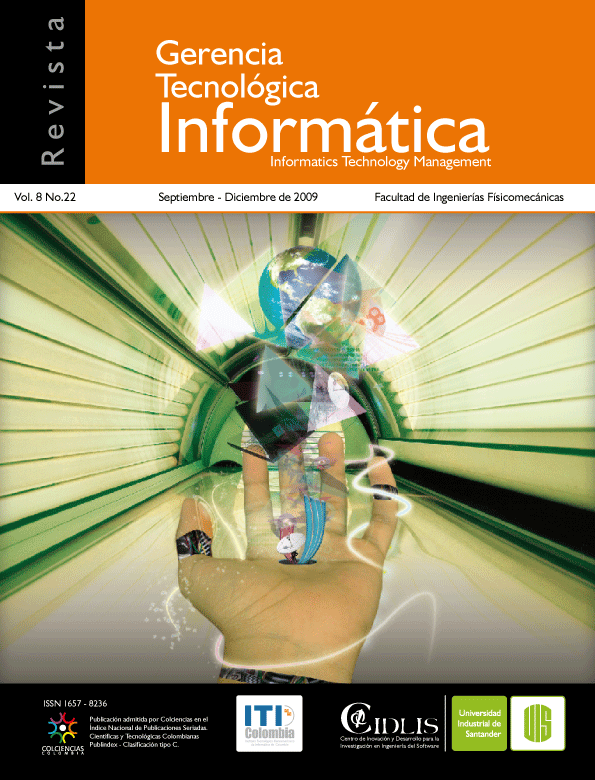IMPLEMENTACIÓN DEL ALGORITMO LMS EN LA PLATAFORMA DSPIC PARA LA ELIMINACIÓN DE RUIDO ACÚSTICO SINUSOIDAL
Publicado 2010-08-02
Cómo citar
Resumen
RESUMEN
En este artículo se presentan los resultados de implementar el algoritmo de filtrado adaptativo LMS (Least-Mean-Square) para la eliminación de ruido acústico sinusoidal, en una plataforma de audio con base un controlador digital de señales (DSC), DSPIC33FJ256GP710.El objetivo general de este trabajo es comprobar la capacidad del DSC en el filtrado adaptativo señales de audio en tiempo real, el cual puede extrapolarse a otro tipo de señales en el mismo rango de frecuencia. El algoritmo fue implementado en lenguaje C empleando el compilador C30, con una estructura tipo FIR y dos tipos de datos, punto flotante y punto fijo, la evaluación de los resultados fue realizada utilizando MATLAB, para lo cual se desarrollo un script que permite la reproducción de señales de audio con la adición de ruido sinusoidal, evaluando las señales antes y después del filtrado adaptativo. Los resultados fueron satisfactorios usando el algoritmo desarrollado en punto fijo, el cual aprovecha la arquitectura del DSC para la ejecución de aritmética fraccional; dejando como conclusión que el dispositivo cumple con las expectativas para el tratamiento en tiempo real de este tipo de señales.
PALABRAS CLAVES: DSPIC, Ruido Acústico, Filtrado adaptativo, Algoritmo LMS.
ABSTRACT
This article presents the results of implementation of the adaptive filtering algorithm LMS (least-mean -square) for the elimination of the acoustic noise is removal, on a platform based on the audio in the digital controller (DSC), DSPIC3FJ256GP710. The purpose of the general of this work is to test the performance of DSC to a be adaptive audio filters with the signal audio in the real time, which can be extrapolated to the signal on the same frequency range. The algorithm was worked inc using the c30 compiler, with a structure with a FIR (Finite Impulse Response) and two types of data, floating point and fixed point, the evaluation of the results was performed using a Matlab, and is developing a scrip that will allow to playback the audio signals with the addition of the sinusoidal noise, evaluating the signal before and after adapting the filter. The results were satisfactory, using the algorithm in point fixed, which was uses the DSC and the architecture for the implementing arithmetic fractional. This leads to the conclusion that the device did the correct function with the expectations for the treatment in the real time with its type of signal.
KEYWORDS: DSPIC, Acoustic Noise, Adaptive filters, LMS algorithm.
Descargas
Referencias
- Sörnmo Leif, Laguna Pablo, Bioelectrical SignalProcessing in Cardiac and Neurological Applications, ACADEMIC PRESS, ( año 2005).
- Farhang-Boroujeny B., “Adaptive Filters: Theoryand Applications Willey & Sons, (año 1999)
- Vicente Luis, Masgrau Enrique, Sebastián J.Miguel, Communication Technologies Group,Aragon Institute of Engineering Research,University of Zaragoza María de Luna, 1, E50018,Zaragoza, Spain
- Microchip Technology Datasheet., [Onlinedocument]. Disponible en www.microchip.com/downloads/en/DeviceDoc/70286A.pdf
- Oppenheim, Alan - Schafer, Ronald TratamientoDe Señales En Tiempo Discreto, Prentice Hall ,(año 2004)
- Angulo, José María Microcontroladores AvanzadosDspic, Thomson Education , (año 2006)
- Proakis, Jhon G Tratamiento Digital De Señales,Pearson Education, (año 2006).
- Widrow Bernard, Stearns Samuel D. AdaptiveSignal Processing, Prentice Hall, (año 1985).
- Mínguez Olivares, Antonio, Tesis doctoralIngeniería avanzada para sistemas de controlde ruido acústico aéreo mediante técnicasadaptativas, Universidad Politécnica de Madrid ,(año 1998)
- Shetty, Kiran Kumar A Novel Algorithm For UplinkInterference Suppression Using Smart Antennas InMobile Communications, Florida state University,(año 2004)
- Sen M. Kuo – Dennis R. Morgan. Active NoiseControl System. Ed. New York, John Willey & Sons,(año 1996.)
- Etter, Delores M. Solución de problemas deingeniería con Matlab, Prentice Hall, México , (año2005)
- Báez López, David. MATLAB con aplicacionesa la ingeniería, física y finanzas, alfaomega(año 2006)
